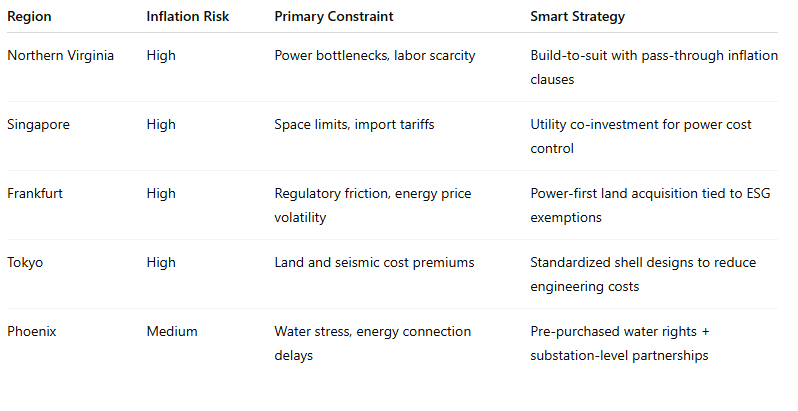Cost Shock: Why Data Center Models Are Breaking and Who Will Win Because of It
Development costs have surged $2.3M per megawatt since 2022 reshaping what gets built, funded, and delivered in the data center sector globally.
Welcome to Global Data Center Hub. Join 1000+ investors, operators, and innovators reading to stay ahead of the latest trends in the data center sector in developed and emerging markets globally.
What You’ll Learn
How a $2.3M/MW cost increase is reshaping data center project viability worldwide
Why inflation now cascades across inputs, timelines, financing, and competition
How top operators are using scale, phasing, and sourcing to control volatility
Where capital is shifting toward Tier 2 markets with cost and delivery advantages
What financing structures are helping mitigate inflation and execution risk
When macro shifts in rates, tariffs, and trade will impact project timing and returns
The global data center sector needs $6.7 trillion in capital by 2030.
But while investors obsess over AI demand curves and sovereign workloads, a more immediate threat is exploding behind the scenes:
Cost inflation.
Across top markets, costs per megawatt have risen $2.3 million since 2022. That’s a 46% gap between modeled and actual capital requirements.
For a standard 36MW hyperscale campus, that's an $82.8 million shortfall, uncaptured in most investment theses.
This isn’t just a budgeting issue. It’s redrawing the investor landscape:
Projects once deemed “shovel-ready” are now stalled or abandoned.
Operators with scale and supply chain control are leapfrogging mid-market peers.
Capital is moving away from Tier 1 markets, not because demand has faded, but because costs can no longer be absorbed.
The Four-Layer Breakdown: Where Projects Start to Crack
What makes today’s cost crisis dangerous isn’t just the numbers, it’s the sequence.
The escalation doesn’t happen in isolation. It cascades.
1. Input Shock
Steel and aluminum premiums are up 30%
Tariffs on mission-critical electrical and cooling components now reach 30–42%
Lead times are stretching into quarters, not weeks
Every dollar of cost inflation here becomes a force multiplier downstream.
2. Timeline Drift
Equipment delivery windows have ballooned
Build schedules are extending 4–8 months on average
Carrying costs and interest accrual are eating into returns before lease-up begins
Every delay adds pressure to the capital stack and compresses exit flexibility.
3. Capital Cost Amplification
Higher interest rates are magnifying budget drift
Lenders are demanding fatter contingencies and more equity
Some previously bankable sponsors can no longer clear debt thresholds
In this environment, project viability is being determined less by tenant demand and more by financing risk tolerance.
4. Competitive Reordering
The result? A sharp divide:
Top players can hedge, procure, and absorb shocks
Mid-tier developers are delaying or scaling back
Subscale sponsors are becoming acquisition targets—or walking away
This is the most significant value migration in digital infrastructure since the cloud buildout began.
What Smart Capital Is Doing Differently
While many sponsors are reacting late, top-tier developers and institutional investors are applying playbook-level precision to ride the cost wave instead of being crushed by it.
Here’s how:
1. Scale Recalibration
Average land transactions have grown 144% since 2022
Multi-building campuses now dominate due to shared procurement, labor, and energy costs
Developers are baking in flexibility across phasing, shell builds, and IT load composition
Scale is no longer just a growth strategy, it’s an inflation shield.
2. Strategic Geography Rotation
The old hierarchy—Ashburn, Singapore, Frankfurt—now comes with premium pain.
Instead:
Markets like Querétaro, Chennai, and Phoenix offer lower land and labor costs
Power-first site selection is replacing cloud-first location theory
Inflation sensitivity is now part of the site selection model
The question is no longer “Where’s the demand?” It’s “Where can we deliver economically viable capacity?”
3. Supply Chain Architecture
Leaders aren’t just buying smarter. They’re designing procurement as a strategic function:
Dual-sourcing essential components across geographies
Forward-buying and inventory warehousing for switchgear and generators
Vendor partnerships that optimize for price stability, not just lowest bid
In today’s market, procurement speed and certainty equal execution edge.
4. Capital Stack Engineering
The new capital rulebook looks like this:
Development agreements tied to inflation-indexed contracts
Capital release schedules that adjust to milestones, not calendar months
Risk-sharing clauses with contractors and OEMs to protect IRRs
The sponsors still standing in 2026 will be those who started structuring for volatility in 2024.
Risk Maps Are the New Market Maps
Here’s how the inflation pressure landscape is reshaping investor strategies:
Why This Can’t Wait
Three macro signals make this a now-or-never window:
Tariffs and trade restrictions are accelerating, not easing
Interest rate normalization is unlikely before late 2025 or 2026
First-mover developers are locking up land, power, and PPA pathways in the best inflation-adjusted corridors
This isn’t a wait-and-see cycle.
If you're not adapting, you're already exposed.
Strategic Implications for Investors
This cascade of costs creates a decision point for every fund, operator, and allocator:
1. Re-Underwrite Everything
Recalculate CapEx and timelines on every unbuilt MW.
Projects that made sense in 2022 may be underwater today.
2. Prioritize Execution over Access
Demand is not the issue.
Delivery is.
Focus on teams and geographies that show repeatable build discipline, cost containment, and supplier reliability.
3. Spot the Dislocation
Stranded projects in Tier 1 markets may be bought at a discount
Secondary markets are mispriced relative to their inflation protection
Mid-tier operators with strong pipelines but poor procurement may be ideal JV candidates
The winners won’t just build faster.
They’ll build smarter—while everyone else recalculates budgets and misses the wave.


